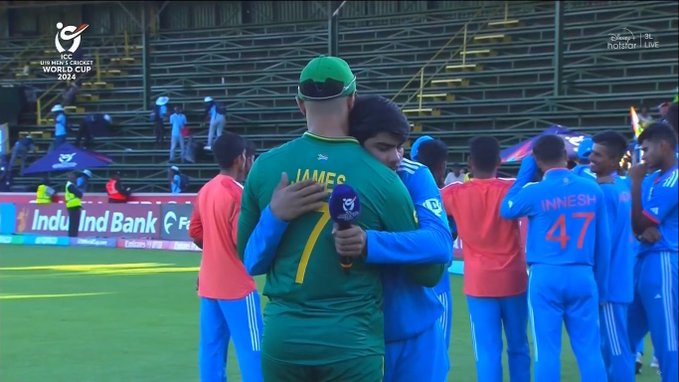
It was a scene that many would recognise on the cricket pitch in Benoni on Tuesday. Indian players enthusiastically rushing onto the pitch after securing their place in yet another ICC U19 World Cup final – a remarkable fifth consecutive time and the ninth overall, while South African cricketers visibly devastated, with some unable to hold back their tears. Following an intense battle spanning 98.5 overs, the match took dramatic turns, ultimately concluding with a powerful cover drive by Raj Limbani. This shot ignited jubilant celebrations among the Indian team while leaving the hosts in despair.
A South African cricketer was overcome with emotion after their loss in the U19 World Cup semi-final to India. The captain of the Indian team, Uday Saharan, offered a comforting embrace to the South African skipper, Juan James.
As soon as the ball left Limbani’s bat and sailed past the cover and mid-off fielders, the Indian cricketers quickly assembled near the boundary rope. Captain Uday Saharan firmly blocked the others with his outstretched arms. The brief pause as the ball made its way across the boundary line felt like an endless stretch of time. But when it happened, they rushed in with Saharan leading the way, shouting at the top of his lungs. It’s hard to imagine that he was venting his frustration towards the person who just moments ago scored the winning runs and then got him run out.
Experience the excitement of cricket in a whole new way, only on HT.Discover now!
Contrasting scenes unfolded within the South African camp. Tristan Luus and Nqobani Mokoena were sprawled out on the ground. Several individuals were visibly emotional. Kwena Maphaka, the standout performer of the tournament with the highest number of wickets, was observed making earnest efforts to comfort his fellow teammates. Regardless of the age group, witnessing a South African cricket team struggle in a crucial match is always unsettling, but unfortunately, it has become a common occurrence.
Shortly after, Saharan was observed exchanging greetings and embracing his South African counterpart, Juan James. It was an extraordinary semi-final.
Following a target of 245, South Africa got off to a fantastic start with Maphaka taking a wicket on the very first ball of the innings.Adarsh Singh struggled to defend against a well-directed bouncer, resulting in an awkward prod to the keeper.
India’s hopes were dashed yet again as Tristan Luus’ well-executed bouncer caught Musheer Khan off guard, leading to jubilant celebrations in the South African camp. The dismissal of the tournament’s top run-scorer marked a significant turning point in the match.
India displayed great patience, patiently waiting until the seventh over to secure their first boundary. It was Arshin Kulkarni who delivered a powerful shot, earning them a maximum off Maphaka. Regrettably, India’s fleeting moment of joy was quickly overshadowed by their mounting difficulties, as Arshin became a victim of Luus in the final over of the Powerplay.
The situation in India took a turn for the worse when Moliya, who had successfully hit a boundary off the first ball of Luus’ over, was dismissed while trying to play a loose drive.
A remarkable performance from 32/4
In a challenging scenario, captain Saharan and Sachin Dhas displayed exceptional teamwork and skill, leading to an impressive rescue mission. Amidst a challenging situation, the duo skillfully balanced prudence and assertiveness to maintain a steady flow of runs on the scoreboard.
With a keen eye for the game, Dhas demonstrated his skill by hitting three boundaries in a single over, helping India regain their momentum. As Saharan maintained a strong presence, Dhas took on a more assertive approach, reaching a fifty off just 47 deliveries to ensure that the required run rate stayed below 6.
Saharan confidently established his momentum with an impressive boundary off James, not only solidifying the 100-run partnership for the fifth wicket but also surpassing Musheer Khan to secure the leading position on the tournament run-scoring charts.
The partnership between the two showcased their exceptional skills in constructing an innings and pursuing victory. They consistently capitalised on singles and skillfully dispatched any loose deliveries for boundaries.
The skipper also joined in, achieving his fifty off 88 balls with a boundary as India moved closer to victory.
As the required run rate reached a run-a-ball, Dhas and Saharan confidently hit James for a six and four, bringing a sense of calm to the Indian camp.
However, South Africa had a surprising turn of events when Maphaka was brought back into the attack. He outsmarted Dhas with a cleverly disguised slower ball, leaving the batter just shy of a century on 96.
The wicket resulted in a decrease in scoring, and the increasing tension became noticeable. Aravelly Avanish showed remarkable composure as he confidently hit a vital boundary off Norton on the last delivery of the 46th over.
Maphaka’s 47th over proved to be a game-changer as he took a crucial wicket off the last ball of his spell. Avanish was dismissed thanks to a brilliant catch by Norton in the deep. Just moments later, the game took another unexpected turn as Abhishek Murugan was caught off guard by a brilliant throw from Marais, leaving him stranded outside his crease.
The two wickets added to the intensity of the match, but a surprising six from Raj Limbani changed the dynamics, leaving India with just nine runs to win in the last two overs.
Saharan dashed any hopes of a South African comeback by hitting four runs off the first ball of the penultimate over. In a surprising turn of events, Saharan was caught out while desperately attempting to secure the decisive run.
Once again, Limbani delivered in a crucial moment, hitting a four off the last ball of the over to maintain their undefeated streak and secure a spot in the final.
Source – Hindustan Times
